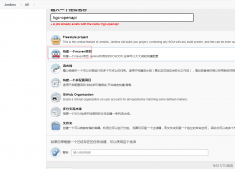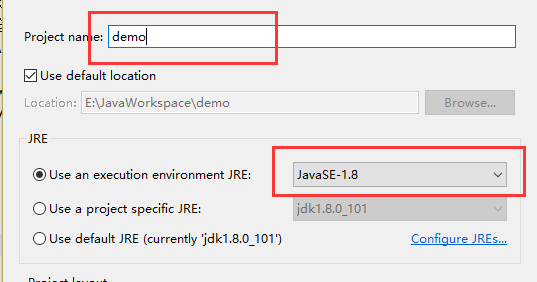基本环境搭建
1、数据库 和 实体类 的名字相同,实体类 属性名即 数据库 字段名。

2、创建 实体类 对应 dao 类,持久层框架 mybatis 正处于学习中,这里就用原始的 jdbc 操作了。
3、创建一个 java 类,作为 controller,处理请求。
4、crud 涉及到 显示数据、修改、添加的页面;删除就不需要了,修改和添加使用同一个页面。所以就有 index.jsp(一个超链接跳转到 show.jsp)、show.jsp(显示所有员工信息和操作链接)、input.jsp(用于修改和添加)。
具体实现
接下来就是 crud 的具体实现了,顺序为 查询显示所有员工信息-->删除-->添加-->修改。
在具体的实现前,需要了解一下 controller 类的大致结构:
|
1
2
3
4
5
6
7
8
9
10
11
12
13
14
15
|
package com.taohan.controller;//import *;@controller@suppresswarnings("all")public class curd { @autowired private departmentinfodao departdao; @autowired private employeeinfodao empdao; //在后面的具体描述中,就只贴出 处理对应请求的方法代码了} |
查询
① 在 index.jsp 页面中加入下面超链接,用于 获取到所有员工集合,保存到 域对象 中,最后 转发(内部跳转) 到 show.jsp 进行显示。
|
1
|
<a href="emps" rel="external nofollow" >员工信息</a> |
② 该请求会交由 controller 中的指定方法处理,下面就需要定义处理该请求的方法。
|
1
2
3
4
5
6
7
8
|
//获取所有的员工信息 @requestmapping("/emps") public string getemps(map<string, object> map) { //获取员工集合,存入 map 集合中 map.put("emps", empdao.getemployees()); return "show"; } |
③ 现在已经获取到了员工集合了,接下来就是编写 show.jsp 页面了。
|
1
2
3
4
5
6
7
8
9
10
11
12
13
14
15
16
17
18
19
20
21
22
23
24
25
26
27
28
29
30
31
32
33
34
35
36
37
38
39
40
41
42
43
44
45
46
47
48
49
50
51
52
53
54
55
56
57
58
59
60
61
62
63
64
65
66
67
68
69
70
71
72
73
74
75
76
77
78
79
80
81
82
83
84
85
86
|
<%@ page language="java" import="java.util.*" pageencoding="utf-8"%><%@ taglib prefix="c" uri="http://java.sun.com/jsp/jstl/core" %><%string path = request.getcontextpath();string basepath = request.getscheme()+"://"+request.getservername()+":"+request.getserverport()+path+"/";%><!doctype html public "-//w3c//dtd html 4.01 transitional//en"><html> <head> <base href="<%=basepath%>"> <title>员工信息</title> <meta http-equiv="pragma" content="no-cache"> <meta http-equiv="cache-control" content="no-cache"> <meta http-equiv="expires" content="0"> <meta http-equiv="keywords" content="keyword1,keyword2,keyword3"> <meta http-equiv="description" content="this is my page"> <!-- 这里导入了一个 jquery 文件,属于静态资源了 静态资源不能被加载的处理: 在 springmvc 的配置文件中加入 <mvc:annotation-driven></mvc:annotation-driven> <mvc:default-servlet-handler/> 详细信息后面我也会具体说明 --> <script type="text/javascript" src="${pagecontext.request.contextpath }/js/jquery.js"></script> </head> <body> <table border="1" cellpadding="3" cellspacing="0"> <caption>员工信息</caption> <tr> <th>编号</th> <th>姓名</th> <th>性别</th> <th>年龄</th> <th>地址</th> <th>部门</th> <th>操作</th> </tr> <c:choose> <c:when test="${not empty requestscope.emps }"> <c:foreach items="${requestscope.emps }" var="emp"> <tr> <td>${emp.employeeid }</td> <td>${emp.employeename }</td> <td> <c:if test="${emp.employeesex == 1 }">男</c:if> <c:if test="${emp.employeesex == 0 }">女</c:if> </td> <td>${emp.employeeage }</td> <td>${emp.employeeaddr }</td> <td>${emp.depart.departname }</td> <td> <!-- 这里可以有两种方式进行删除,值得注意的是:这两种删除的方法对应的 url 是有区别的。 但是,本文主要就是使用 rest 风格的 url 进行操作,所以,还是使用第二种方法吧。 --> <!-- <a href="${pagecontext.request.contextpath }/del/${emp.employeeid }">删除</a> --> <a onclick="return del(this)" href="${pagecontext.request.contextpath }/emp/${emp.employeeid }">删除</a> <a href="update/${emp.employeeid }">修改</a> </td> </tr> </c:foreach> </c:when> </c:choose> </table> <form action="emp" method="post"> <!-- 用于将 post 请求转换为 delete请求 --> <input type="hidden" value="delete" name="_method" /> </form> <script type="text/javascript"> //将 get 请求转换为 post 请求提交 function del(tag) { //获取当前请求路径 var href = tag.href; //提交 $("form").attr("action", href).submit(); return false; } </script> <a href="preadd">添加员工</a> </body></html> |
到这里,整个查询就结束了!
删除
在上面的 show.jsp 页面代码中有两种请求方式可以进行删除。
㈠ 使用 get 请求进行删除
使用此请求方式的请求路径大致为:127.0.0.1:8080/项目名/del/id。那么,后台 controller 类中就要有一个对应处理 /del/id 这样请求的方法。
|
1
2
3
4
5
6
7
8
9
10
11
|
//根据员工编号 删除员工 @requestmapping(value="/del/{id}") public string delemp(@pathvariable("id") integer id) { // row 受影响行数,这里就不做成功与否的判断了 int row = empdao.isdel(id); //这里的请求路径为 del/id 是二级目录 //redirect:前缀表示重定向到 ../emps 路径,就是前面查询的路径,默认(不写)是转发。 //删除后要重新获取员工数据,再转发到 show.jsp 显示,不能直接转发到 show.jsp 页面,因为并没有数据,所以需要先查询,再转发。 return "redirect:../emps"; } |
上面就是使用普通 get 请求处理删除请求。
㈡ 使用 delete 请求进行删除
我们知道,hiddenhttpmethodfilter 类可以将 post 请求转换为 我们指定的其他请求方式。在我的这篇文章主要讲解了 hiddenhttpmethodfilter 类的处理过程。这里,由于在 show.jsp 页面中的删除超链接是一个 get 请求。所以,我们需要使用 js 将 get 请求使用 post 请求发送,并且转换为 delete 请求。所以,在 show.jsp 页面就有了一个表单 和 一个隐藏的 input 标签。
|
1
2
3
4
5
6
7
8
9
10
11
12
13
14
|
<form action="emp" method="post"> <!-- 用于将 post 请求转换为 delete请求 --> <input type="hidden" value="delete" name="_method" /> </form> <script type="text/javascript"> //将 get 请求转换为 post 请求提交 function del(tag) { //获取当前请求路径 var href = tag.href; //提交 $("form").attr("action", href).submit(); return false; } </script> |
使用此请求方式的请求路径大致为:127.0.0.1:8080/项目名/emp/id。那么,后台 controller 类中就要有一个对应处理 url 为:/emp/id,请求方式为:delete 这样的请求的方法。
|
1
2
3
4
5
6
7
|
//根据员工编号 删除员工 使用 delete 请求,method属性就指定了请求方式 @requestmapping(value="/emp/{id}", method=requestmethod.delete) public string delemp(@pathvariable("id") integer id) { int row = empdao.isdel(id); return "redirect:../emps"; } |
上面代码中出现了一个 requestmethod,它是一个 枚举类型,其中的值就是各种请求方式。

(requestmethod)
以上就是两种使用两种方式进行删除的示例了!
添加
① 在 show.jsp 页面最下面有下面这样的一个超链接
|
1
|
<a href="preadd">添加员工</a> |
该链接用于跳转到 input.jsp 页面,至于需要后台进行处理,是因为需要加载出所有的部门,用于添加的时候选择。
② 处理 preadd 请求,获取部门列表
|
1
2
3
4
5
6
7
8
9
10
|
//加载添加页面 @requestmapping("/preadd") public string preadd(map<string, object> map) { //获取部门集合 map.put("departments", departdao.getdeparts()); //input.jsp 页面需要一个 员工对象,但是添加没有,所以给个空的,至于为什么需要,见文末 map.put("employee", new employeeinfo()); return "input"; } |
③ input.jsp 页面,添加和修改公用该页面
|
1
2
3
4
5
6
7
8
9
10
11
12
13
14
15
16
17
18
19
20
21
22
23
24
25
26
27
28
29
30
31
32
33
34
35
36
37
38
39
40
41
42
43
44
45
|
<%@ page language="java" import="java.util.*" pageencoding="utf-8"%><%@ taglib prefix="c" uri="http://java.sun.com/jsp/jstl/core" %><%@ taglib prefix="form" uri="http://www.springframework.org/tags/form" %><%string path = request.getcontextpath();string basepath = request.getscheme()+"://"+request.getservername()+":"+request.getserverport()+path+"/";%><!doctype html public "-//w3c//dtd html 4.01 transitional//en"><html> <head> <base href="<%=basepath%>"> <title>添加/修改页面示例</title> <meta http-equiv="pragma" content="no-cache"> <meta http-equiv="cache-control" content="no-cache"> <meta http-equiv="expires" content="0"> <meta http-equiv="keywords" content="keyword1,keyword2,keyword3"> <meta http-equiv="description" content="this is my page"> </head> <body> <form:form action="emp" method="post" modelattribute="employee"> <%-- employee对象有编号就是修改 --%> <c:if test="${requestscope.employee.employeeid != null }"> 编号:<form:input path="employeeid" readonly="true"/><br /><br /> <input type="hidden" value="put" name="_method" /> </c:if> 姓名:<form:input path="employeename" /> <br /><br /> 性别:<form:radiobutton path="employeesex" value="1" label="男" /> <form:radiobutton path="employeesex" value="0" label="女" /> <br /><br /> 年龄:<form:input path="employeeage"/> <br /><br /> 地址:<form:input path="employeeaddr"/> <br /><br /> 部门:<form:select path="depart.departid" items="${requestscope.departments }" itemlabel="departname" itemvalue="departid"></form:select> <br /><br /> <input type="submit" value="提交" /> </form:form> </body></html>input.jsp 页面代码 |
从 input.jsp 页面代码中可以看出,添加和修改使用了同一个提交路径(/emp 添加和修改后台需要的就只是一个对象而已),但是它们的请求方式是不同的。
添加操作并没有做任何处理,就是一个 post 请求。
④ 添加员工
|
1
2
3
4
5
6
7
|
//添加 post 请求就是添加 @requestmapping(value="/emp", method=requestmethod.post) public string isadd(employeeinfo emp) { int row = empdao.isadd(emp); return "redirect:/emps"; } |
小结: 添加 和 修改使用同一页面,那么就需要有标识判断 进入当前页面(input.jsp) 的是什么操作,我们就可以根据 员工编号 作为判断标识,如果该员工没有编号(在 /preadd 请求处理方法中创建了一个空的员工对象放到了域对象中)就是添加;如果有员工编号就是修改,则使用 _method 设置需要将 post 请求转换为 put 请求。
修改
① 在 show.jsp 页面中每个员工后面都有一个修改链接,如下:
|
1
|
<a href="update/${emp.employeeid }">修改</a> |
② 后台代码处理 update/id 请求,获取要修改的员工对象,放入域对象,转发到 input.jsp 页面显示。
|
1
2
3
4
5
6
7
8
9
10
11
12
13
|
//加载修改页面 @requestmapping(value="/update/{id}", method=requestmethod.get) public string preupdate(@pathvariable("id") integer id, map<string, object> map) { //根据编号获取到要修改的员工对象 employeeinfo emp = empdao.getempbyid(id); map.put("employee", emp); //加载所有部门信息 map.put("departments", departdao.getdeparts()); return "../input"; } |
③ 在 input.jsp 页面的 springmvc自带的 form标签会将对应的员工属性信息显示在对应的文本框中
④ 修改操作就会有一个隐藏的 input 标签,如下:
|
1
|
<input type="hidden" value="put" name="_method" /> |
这样,当修改时 post 请求便会转换为 put 请求。
⑤ controller 类中,就定义方法处理请求url为: /emp,请求方式为:put 的请求
|
1
2
3
4
5
6
7
|
//修改 @requestmapping(value="/emp", method=requestmethod.put) public string isupdate(employeeinfo emp) { int row = empdao.isupdate(emp); return "redirect:/emps"; } |
以上就是本文的全部内容,希望对大家的学习有所帮助,也希望大家多多支持服务器之家。
原文链接:http://www.cnblogs.com/dream-saddle/p/9391739.html















